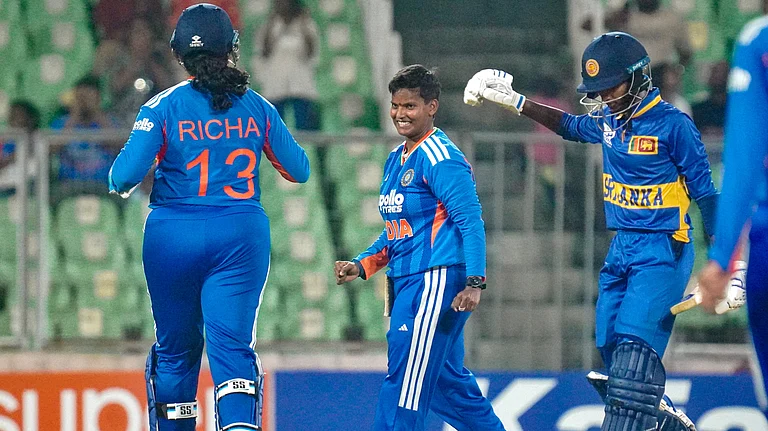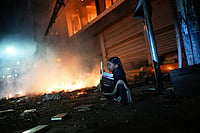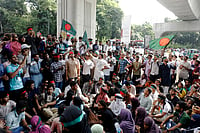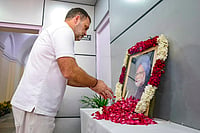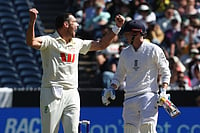It rained arms that night. Around midnight of December 16-17, 1995, villagers of Purulia, West Bengal, who happened to be at the wrong place at the right time, were taken aback by the consignment of sophisticated weaponry that fell from the sky. Also left groping in the dark were India's investigative and intelligence agencies. Outlook's effort to piece together a version of what really happened from sources familiar with the case makes the case curiouser and curiouser.
On December 10, 1995, an AN-26 landed at Burgas, Bulgaria, to collect 77 wooden cases of arms. The consignment contained 300 AK-47 assault rifles, 15 Makarov pistols, two sniper rifles with night-vision sights, two night-vision binoculars, 25,000 rounds of rifle ammunition, 6,000 rounds of pistol ammo, 10 rpg-7 rocket launchers, 100 grenades, 100 anti-tank grenades and 25 PM79 anti-personnel mines - enough arms to take on a small army. It appears the British intelligence had advance information about the operation in September but passed it on to the RAW only in late November that year.
That intelligence said an AN-26 would land in an unused airfield in the Dhanbad area and a consignment of arms would be unloaded. The coordinates were given. RAW disseminated this information, and among others, it went to the IB. The then director IB (DIB), D.C. Pathak, asked his deputy in Patna for relevant follow-up. The fix on the airfields were narrowed down to three or four unused ones and an alert was sounded. IB joint director P. Guha was asked to monitor the case.
Nothing further was heard till December 17 morning, when the IB was 'informed' of the Purulia airdrop. It was only later that afternoon that the IB received a RAW input, sourced from reliable channels, that in Karachi the AN-26 had been modified for airdrops, so it was a likelihood they should keep a watch out for. One source said the then RAW secretary "scoffed at this idea" (that such an airdrop could at all be possible). A team under Guha was sent off to Purulia and Calcutta. They found that the plane had been at Varanasi on the night of December 16 and had been in touch with the Calcutta ATC en route to Rangoon. An alert was sent out, but strangely it was confined to northern India.
Then, on the night of December 22 the director, Air Intelligence, informed the DIB that an aircraft with the same numbering had landed at Madras airport. This is where things got really baffling. By the time the IB in Madras was contacted and they in turn alerted the immigration, the aircraft had taken off. But immigration had the names of the people in the aircraft. Madras also told the DIB that the pilot was in touch with the Bombay ATC and had sought permission to refuel. The DIB called Bombay and ordered the aircraft detained. The control tower gave permission for the aircraft to land and alerted air intelligence at Sahar airport. This is where the Keystone Cops business began in right earnest.
As the aircraft began its smooth descent, Murphy's Law went into overdrive. The aircraft landed at Sahar airport and was made to taxi all the way to Santa Cruz. As soon as it was parked in the designated area, an oil tanker trundled up and began to refuel the aircraft. This was followed by the arrival of the Airport Authority people who demanded payment of landing charges and the rest. A gentleman in the aircraft, later identified as one "Kim Davy", was at his charming best. He said he would part with the money at the terminal, which was quite some distance away. He got into the Airport Authority jeep and was politely given a lift to the airport to pay the charges.
Then the immigration officials arrived and searched the plane, and "found concealed in a cavity firearms as well as various packing cases and so on with all kinds of ordnance factory markings".
At this point Madras got in touch with Bombay and inquired about the goings-on. The Bombay IB said that "six" had been detained. Madras asked: "What happened to the seventh?" The only remaining trace of the seventh was his briefcase that apparently contained some documents, pictures and a New Zealand passport bearing the name Kim Palgrave Davy. Later investigations revealed that the name was obtained off a tombstone in New Zealand. It belonged to a boy, dead at the age of two way back in 1962.
SO who was the man who walked out of Bombay airport? Friends apparently called him "Peter" but Interpol believes his real name is Niels Christian Nielsen, born in Denmark in December 1961. Copenhagen police records apparently show Nielsen was arrested in May 1982 for two roberries and money laundering, but "escaped".
Following his scandalous second escape in Bombay, CBI director Vijay Rama Rao accepted responsibility to investigate the case at a Committee of Secretaries meeting. Two aspects came in for sustained scrutiny: the IB's role (rather the lack thereof) both in Madras and in Bombay. And its coordination from Delhi. Home ministry sources familiar with the case say the CBI prepared a document that blamed the then IB director. In June 1996, the displeasure was conveyed to the IB director through a read-and-destroy note, a first of sorts. Apparently some displeasure was incurred as a result of the handling of the isro "spy" case as well. Sometime after that Pathak was sent to the jic, an established dumping ground, and Abhijit Mitra was made acting director.
So what really happened at Purulia? Even while the arms drop accused were being handed their sentences early this year, over 50 AK-47 rifles, 15 9mm pistols, 35 hand grenades, 25 anti-tank grenades, a couple of Druganov sniper rifles and over 15,000 rounds of ammunition reportedly remained untraceable. Where did these go? Whom was the consignment meant for? There are some clues. The Latvian-turned-Russians were hired for about $1,000 per month for work based out of Dhaka. Since it was a monthly salary it's believed that other drops may also have been planned. There is also the fact that Davy let it be known that the quote of the arms shipment should specify it as being meant for delivery to Calcutta port.
In Karachi, the Shaheen International, believed to be linked to the ISI, handled the aircraft. The improvisation had one curious aspect, the pallets that were meant to enable the drop were made of wood, and not of steel or alloy. It is believed that over the actual drop zone, some of these wooden rollers got stuck and some of the drop was done after the coordinates fed into the global positioning system of the aircraft had been crossed. The cases were marked "technical equipment" and "central ordnance depot, Rajendrapur Cantonment, Bangladesh". At that point of time, the Pakistan media is reported to have criticised the Pakistani government for not preventing the drop. The CBI alleged that the arms were meant for the shadowy Ananda Marg cult. There was also evidence of some involvement of the Bangladeshi intelligence agency DGFI
The Hong Kong-based "company" that was set up to purchase the aircraft as well as the arms referred to one Altaf Hussain Chaudhury, a former Bangladeshi air chief. So who were the intended end-users? Who was "Kim Davy" working for? How strong is the Ananda Marg angle? What would they do with sophisticated anti-tank weapons? These are questions that might now never be answered.










